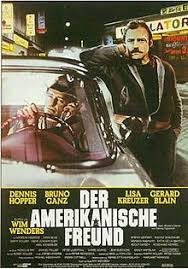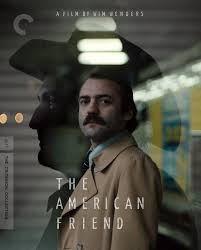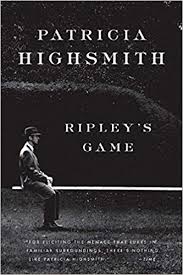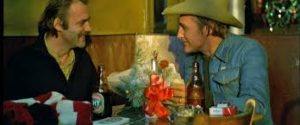

The American Friend, otherwise known in German as Der Amerikanische Freund, is a crime film. Although in France it would be considered a neo-noir film. A neo-noir film is the new version of the genre “film noir”. Film Noir came about in France in 1955 and was used to describe a movie that had more sinister story lines. The term film noir translates in English to “dark movie”. Typically in Neo-noir films they like to use slightly tilted camera angles for an unsettling feel or even unbalanced frames. Typically the line between good and bad is blurred and the common theme is revenge.
The American Friend is an adaptation of a book written by Patricia Highsmith,  it was called Ripley’s Game. The movie itself is about a man named Tom Ripley. Ripley is a very wealthy American living in Germany. Ripley makes a living by scamming people at auctions for fake art. His partner would bring out some forged paintings and Ripley would be in the crowd raising the price in the auction. While doing his usual scheme he meets a very sick man named Jonathon Zimmermann. Zimmermann is a picture framer and doesn’t have much respect for Ripley. The movie goes on to tell a twisted tale of Ripley making Zimmermann believe that he’s far more ill than he really is. He even went so far as to forge medical results to make Zimmermann desperate and more open to living a life of crime. Zimmermann is actually unaware of Ripley’s part in falsifying his medical records and forms a kind of bond with him. This leads to Ripley protecting Zimmermann in a way from a gangster that wants to use him in a murder. Zimmermann begins to think that the mafia wants to kill him so him and Ripley set up in his mansion to wait for their attackers. Zimmermann and Ripley kill their almost-assassins and then load their bodies up into an ambulance for disposal. In the end Zimmermann does find out that his medical records were faked and ends up abandoning his partner Ripley. Zimmerman ends up dying from some unknown reason while he’s driving away and that’s the end of the movie.
it was called Ripley’s Game. The movie itself is about a man named Tom Ripley. Ripley is a very wealthy American living in Germany. Ripley makes a living by scamming people at auctions for fake art. His partner would bring out some forged paintings and Ripley would be in the crowd raising the price in the auction. While doing his usual scheme he meets a very sick man named Jonathon Zimmermann. Zimmermann is a picture framer and doesn’t have much respect for Ripley. The movie goes on to tell a twisted tale of Ripley making Zimmermann believe that he’s far more ill than he really is. He even went so far as to forge medical results to make Zimmermann desperate and more open to living a life of crime. Zimmermann is actually unaware of Ripley’s part in falsifying his medical records and forms a kind of bond with him. This leads to Ripley protecting Zimmermann in a way from a gangster that wants to use him in a murder. Zimmermann begins to think that the mafia wants to kill him so him and Ripley set up in his mansion to wait for their attackers. Zimmermann and Ripley kill their almost-assassins and then load their bodies up into an ambulance for disposal. In the end Zimmermann does find out that his medical records were faked and ends up abandoning his partner Ripley. Zimmerman ends up dying from some unknown reason while he’s driving away and that’s the end of the movie.
The director Wim Wenders originally wanted John Cassavetes to play the part of Ripley but he said no and suggested that Dennis Hopper be used instead. Dennis Hopper was a very well known actor with a reputation “as a Hollywood enfant terrible” which means that he was a bit unconventional and controversial. It’s been said that Wim Wenders has a very keen fascination with everything American and that’s very apparent in this movie as Ripley is a cowboy hat-wearing American. At the time of production Hopper was having a particularly hard time in life but that only enriched his performance in The American Friend. At one point he even improvised a scene where he takes pictures of himself with a Polaroid camera while he’s crying. He also uses a decent amount of other American symbols such as “a yellow New York taxi, a Thunderbird car, his jeans trousers and jacket, his cowboy hat, his jukebox and Coca-Cola machine, the pool table and Marlboro cigarettes. These numerous extra-filmic echoes add an additional dimension to Wenders’ portrayal of the impact of America on European culture (senses of cinema).

The protagonist in this film is Zimmerman while the antagonist is definitely Ripley. I personally really enjoyed the movie, however that could just be because I’ve never read the book it was based off of. It turns out that when Patricia Highsmith first saw the movie she was incredibly disappointed in the adaptation of the characters. In fact, Ripley was hardly shown for a good part of the movie. People also didn’t seem to be a fan of Ripley wearing a cowboy hat for most of the movie. There also seemed to be some plot holes as well that left viewers feeling a little disappointed in the story line. According to Roger Ebert, a movie reviewer, Wenders had purposely thrown out parts of the story that would’ve made it more cohesive and would’ve made more sense all to prove a point: “that we watch [and read] thrillers as much for atmosphere as for plot” (rogerebert). I can agree with his statement that people are often more intrigued by things at face value than what really lies beneath them. I think that this fact makes The American Friend an art piece or even a social experiment to see how well the movie would do without having to make the most sense.
https://film.avclub.com/the-american-friend-is-a-tom-ripley-movie-that-doesn-t-1798186176
http://sensesofcinema.com/2012/cteq/american-friend/
https://www.criterion.com/current/posts/3866-the-american-friend-little-lies-and-big-disasters
https://www.rogerebert.com/scanners/opening-shots-the-american-friend
